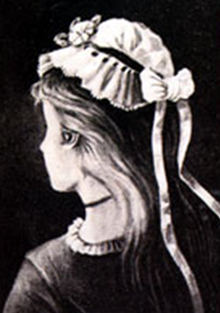My Wife and My Mother-in-Law
Appearance
"My Wife and My Mother-in-Law" is a famous ambiguous image, which can be perceived either as a young girl or an old woman (the "wife" and the "mother-in-law", respectively).
History


British cartoonist William Ely Hill (1887–1962) published "My Wife and My Mother-in-Law" in Puck, an American humour magazine, on 6 November 1915, with the caption "They are both in this picture — Find them".[1] However, the oldest known form of this image is an 1888 German postcard.[2]
In 1930 Edwin Boring introduced the figure to psychologists in a paper titled "A new ambiguous figure", and it has since appeared in textbooks and experimental studies.[3][4]
References
- ^ "My wife and my mother-in-law. They are both in this picture – find them". Prints & Photographs Online Catalog. Library of Congress. Retrieved 9 October 2011.
- ^ Weisstein, Eric W. "Young Girl-Old Woman Illusion". MathWorld. Retrieved 9 October 2011.
- ^ Botwinick, Jack (June 1961). "Husband and Father-in-Law—A Reversible Figure". The American Journal of Psychology. 74 (2).
- ^ Nicholls, Michael E. R.; Churches, Owen; Loetscher, Tobias (23 August 2018). "Perception of an ambiguous figure is affected by own-age social biases". Scientific Reports. 8 (1). doi:10.1038/s41598-018-31129-7.
See also
Wikimedia Commons has media related to My Wife and My Mother-In-Law.
